Trending
Opinion: How will Project 2025 impact game developers?
The Heritage Foundation's manifesto for the possible next administration could do great harm to many, including large portions of the game development community.
On this day in 2004, EA released The Sims 2. In this classic postmortem from Game Developer magazine, Lucy Bradshaw and the Maxis team recount what went right and what went wrong during development.
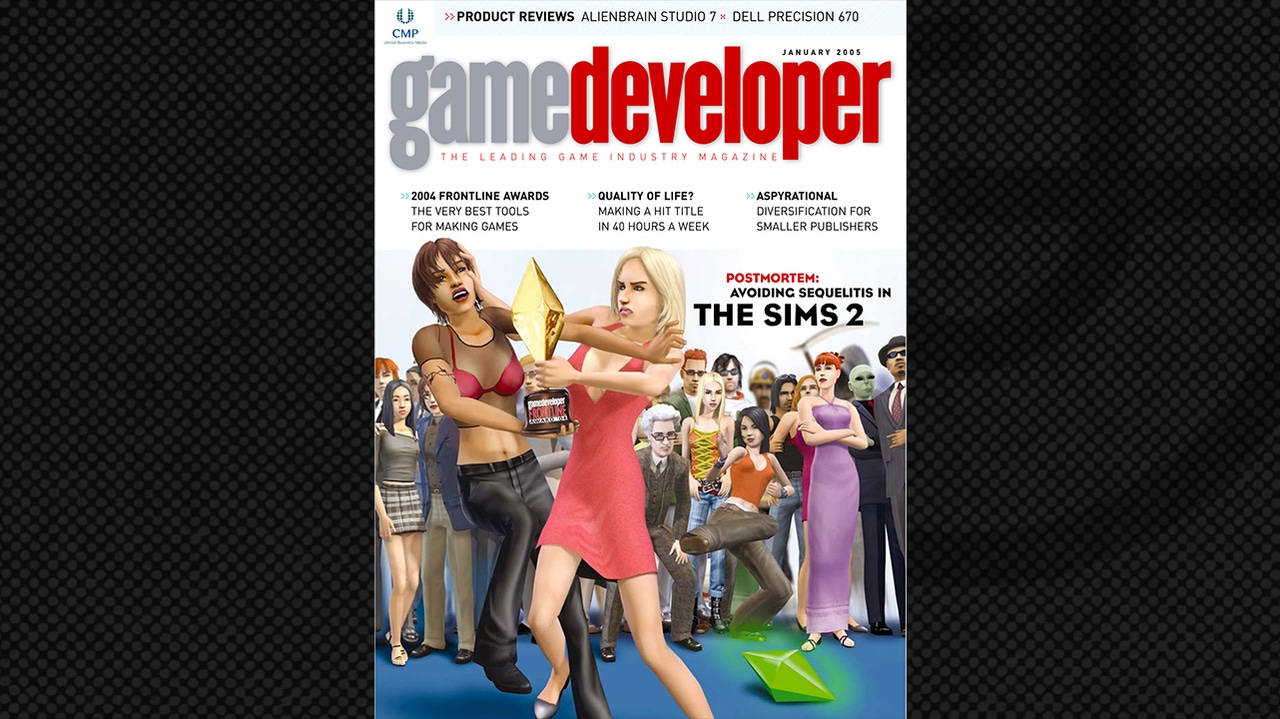
In honor of the 13th anniversary of the release of the one of the best-selling PC games of all time, we present this classic postmortem, which first appeared in the January 2005 issue of Game Developer magazine. This in-depth look at what went right and what went wrong during development was written by Lucy Bradshaw with contributions from fellow Maxis devs Matt Brown, Tim LeTouneau, and Paul Boyle.
Sequels to successful games may seem obvious—maybe even too obvious. And with The Sims, we at Maxis had a lot of content to work with and many leaps in technology to take advantage of since the first game was shipped back in 2000.
Even so, sequels pose a unique challenge. The Sims 2 team had to understand what led to the success of the original and devise a way to evolve (and ultimately how to innovate) while juggling colossal expectations from fans, critics, and the company.
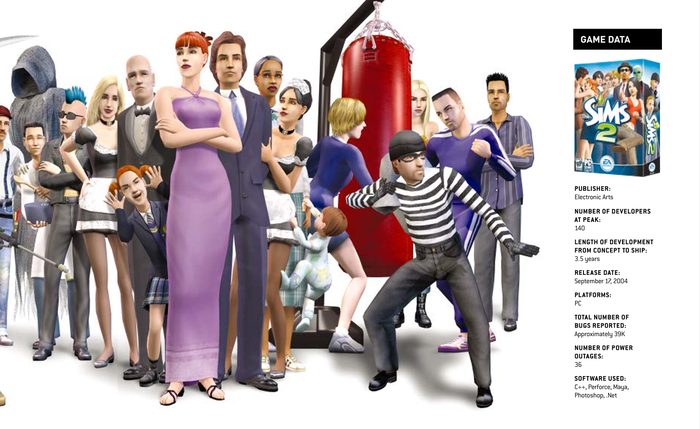
Image via Game Developer Magazine, January 2005.
Maxis has always been a major proponent of rapid prototyping when kicking off a new game. We used early prototypes to resolve look and feel issues, to help understand the key emotional connection, and most importantly, to test out the new gameplay concepts. Building these prototypes during the concept and pre-production phases instead of during the full steam production phase just makes sense.
Many of these prototypes significantly affected the final design of the game. The look-and-feel prototype, for example, established how The Sims look, particularly in the adult and teen years, and set the tone for the new 3D environments.
The HeadToy prototype helped evolve the Create A Sim tool. Later in the project, the "aspiration, wants, and fears" prototype guided the way we created the new gameplay. All of these prototypes were done as separate applications, using existing tools, such as Maya and .Net, and executed by one or two engineers or artists.
Our key to success is being rapid, staying focused on what we're trying to solve and moving quickly. We aim to show progress and iterate frequently. If someone working on a prototype has not shown us something each day of the week, it's probably going sideways.
Each of these prototypes was different in its implementation. The visual look-and-feel prototype was simply a movie, but it set the bar for the lighting, camera, environment, and characters.
The HeadToy prototype gave us a chance to explore some rather extreme possibilities in the new Sims's appearances. It also inspired Sim DNA, the virtual genes that are passed along to Sim descendants. One of the core design concepts that came out of this stage of the project was that The Sims 2 would grow up in The Sims 2.
The prototype not only nailed the various ages and the creative possibilities, but also validated the Sim DNA concept. This influenced the user interface, changed the way we talked about the game, and ultimately became part of the marketing campaign: "Genes, Dreams & Extremes."
We used the "wants and fears" prototype later in the project, but it was critical in providing the major innovation in regard to player focus and gameplay pacing. The prototype, built by Matt Brown and his team, let the designers and the engineers play through the wants and fears trees and establish the logic involved.
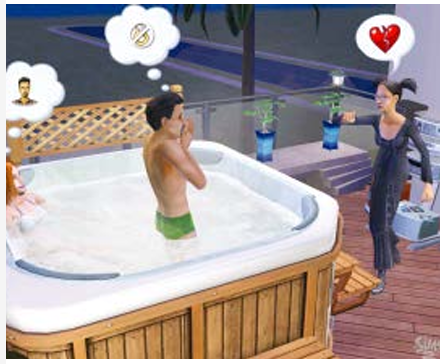
Situational humor helps to create an emotional bond for the player. Image and caption via Game Developer Magazine, January 2005.
Our challenges in making a sequel to The Sims was to intrigue the currently active players as well as recapture players who had uninstalled long ago. The audience of The Sims has changed rather dramatically since the original—they've evolved from hardcore players to ones who are very casual or new to games all together.
We focused on what we felt were some of the key factors of success in The Sims. We worked with our publishing partners to get a picture of our player base.
We also spent a lot of time on the forums in our website, as well as other fan-sites and bulletin boards. We came to several conclusions. One was on the topic of The Sims: a game about people is something that most folks can connect with.
Other factors that we felt were critical were the creativity, the open-ended nature of the experience, and the sense of irreverent humor. We spent a lot of time brainstorming ways to improve these aspects of the game. We enhanced the creativity by improving the Create A Sim module, refining the building and designing options, and by creating a new means of storytelling via moviemaking.
We bolstered the open-ended nature of the game by keeping the same depth and breadth, and by making the lives of the Sims feel richer through additions to the social landscape. Finally, the key to this audience was the addition of growing Sims and playing through the generations of their families.
We recognized that we needed to attract our previous players through innovation. A major lure for these lapsed Sims players was the move to full 3D. This gave us an instant leg-up on the original, but we also parsed a lot of feedback from reviews, player suggestions, and focus groups.
From these outlets, we heard that players were tired of managing the mundane aspects of their Sims' lives—they wanted a new focus and pacing. Another thing we identified from listening to focus groups and player testimonials is that a great many players had not discovered some of the crazy things that could happen in The Sims and its expansions. Players had simply not put together the right combinations of actions and objects to discover these bits.
We boiled this down to the need for new pacing and rewards as well as a need to refine and maintain the open-ended gameplay. We had to find a better way to guide players and expose them to more of the possibilities that we had created.
The entirety of these observations drove much of our brainstorming about features and rewards, and led to the composition of features that we eventually included.
Use once, throw away. Kleenex testing, in our vocabulary, means using disposable testers throughout the design process—from alpha to release candidate. The key to fresh feedback is using each tester only once: just like Kleenex. Since so much of our game hinges on players immediately understanding the gameplay and the interface, and that the rewards hit with good pacing, we elicited feedback and acted upon it regularly throughout the development process.
The most important part of Kleenex testing is finding people who can play a game with someone looking over their shoulders and while voicing the thoughts that go through their heads. Not everyone is cut out to be a piece of Kleenex.
We completely iterated the Create A Sim interface three times because of feedback received during Kleenex testing. This testing allowed us to better categorize the steps and make the flow of Sim design more natural and clear to players. There's quite a bit of depth to creating a Sim, and since a Sim's appearance can be very important to the player, this is an area in which we had to supply both complexity and simplicity (ease of use).
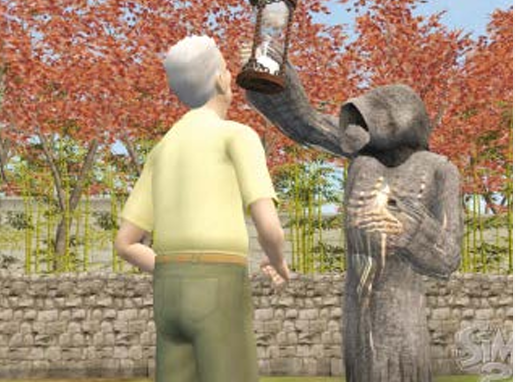
At Maxis, we believe that a great deal of the success of The Sims came from the wealth of content and characters created by our user-base and enthusiast communities. When we initially shipped The Sims in February 2000, we had already created and released tools that enabled fans to create Sim skins. We continued to foster this community by adding more tools to a frequently updated and community oriented web site.
When we embarked upon The Sims 2, our philosophy was: If you could see it on the screen, you should be able to customize it. We also wanted to integrate this capability more seamlessly into the game, making it easier for players to manage the content they gathered or created.
We designed the user interface for data management to realize this goal. We also integrated our web site directly into the game through an in-game browser that allows players to download skins or objects and use them immediately.
In addition to this, we continued to keep an open dialog with the fans and webmasters supporting The Sims. We asked their opinions, got their feedback, and even kept up a weekly mailing on the progress of The Sims 2. We maintained this mailing list for a full year before we shipped.
One very successful event was the launch of The Sims 2 Body Shop, our tool for creating The Sims 2 skins. We made this available to the community on the opening day of E3 2004, when we premiered the game on the show floor. We had more than 80,000 skins on the site by the time we shipped the game.
One problem we encountered with this simple-to-use tool, however, was that we made it easy for users to brand the work of others as their own. We built some solutions into the shipping product and web site to make sure the creator identity is seen (if desired) and made sure we created strong community ethics for our site.
Today, the community is thriving, and player-created content made with The Sims 2 Movie Maker is something we are very proud of.
SWATs are small, cross-discipline teams within the larger development team that tackle key features and technical issues. SWATs (some call them pods or cells) helped The Sims 2 team focus on several fronts, thanks to strong leadership in each group responsible for decisions, communication, and tasks, such as pushing for the completion of their team's projects. On a large team such as ours, this requires an essential tactic. These SWATs evolved over the course of the project, coming together and disbanding as their objectives were initiated or met.
We had a neighborhood SWAT, which was responsible for all the visual features in the neighborhood: everything from the on-the-fly creation of house imposters to the landscape and effects. There was also a neighborhood story SWAT, which built all the finished neighborhoods. This team created all the prebuilt content, relationships, and ephemera so players could jump right in and experience the game.
The Create A Sim SWAT was the team that created the workflow and technology behind the Create A Sim module. The Sims 2 Body Shop SWAT shipped a "product" twice during the production of The Sims 2. The Body Shop had to go through Q/A, CQC, localization, and all the other processes a stand-alone product must weather. This was an amazing team of people.
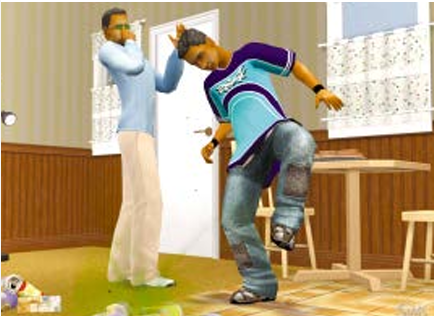
There are more than 11,000 animations in The Sims 2. Image and caption via Game Developer Magazine, January 2005.
One of the most distinctive teams on the project was the believe SWAT. They were saddled with the duty of changing the behavior of our Sims to match the new, more detailed aesthetic.
This team worked together to really put our animation engine, which was designed by David Miller, through its paces. Human beings know how human beings behave.
One of the major challenges we faced in The Sims 2 was matching the motion to the meat. We had to experiment with using the animation engine to its fullest, which extended all the way to adding a breath channel and a very subtle but effective facial movement channel (before we put this in, Sims just looked too noticeably mechanical and creepy—see Steve Theodore's "Uncanny Valley," December 2004).
As for behavior, the challenge was to create new routing, awareness, moods, and personalities which would work autonomously, be eminently interruptible by the player, and provide clear feedback about what was going on with the Sim in question. We knew we had it right when our testers didn't notice it. When we got to that point, we figured we had believable Sims.
There were many other excellent SWAT teams on our project, and they all contributed to the final feature set in ways that could not have occurred without this specific compartmentalization.
Players need to be able to read how their actions affect the game structure. Feedback, therefore, must be simple and intuitive. The believe SWAT team had to experiment a great deal with the behavior and movements of the new Sims in order strike a successful balance. One of these experiments was a bust, which ate up a lot of time and effort.
We were experimenting with bringing the personality dimensions of each Sim to the forefront by enabling players to affect this area to a greater degree. We experimented with animations and behaviors that were intended to show off the extremes of the five personality sliders: neat, nice, outgoing, playful, and active. What we ended up with were crazy looking Sims that were difficult for players to read. We learned a few things from this experiment that ultimately helped us make sharper decisions later in the project.
First, the player really does need simple UI devices that tie well to the Sims' behavior. In the case of the personality sliders, having five that all worked at the same time didn't clearly demonstrate to the user what was happening.
Second, more behavior and angles of interaction are not necessarily better. In the end, we did keep some of these animations and behaviors, but we made them function as additions to Sim characterization rather than another whole dimension of Sim management. The learning from this experiment gone awry also came to bear when we implemented the desperation behavior of our aspiration-challenged Sims. When they exhibit desperation, the behavior is tied to one dimension of the UI with a very clear means of affecting it positively.
In terms of total volume of content, we bit off a lot. The goal of aging Sims meant creating three separate Sim skeletons and designing a rich variety of skins in for five age categories—toddler, child, teen, adult, and elder—and two sexes. In addition, we had to execute unique animations for each age, as well as unique behaviors and voices for each age and sex.
There are more than 11,000 animations, 1,200 skin meshes (textures increase the variety by re-using the same mesh), 40,000 voice samples, not to mention the models, design modes, effects, cinematics, sounds, full text in 21 languages, and music.
During the development, we felt like we were constantly playing catch-up. Getting all the content executed, tracked, and reviewed took a great deal of process invention. Initially, our tracking was not as detailed as it needed to be to follow each asset through the pipeline and transfer the information to the various sections of the team. Even the design specificity needed to be greatly enhanced.
We had to fix these problems after the content generation had already begun. Creating build processes, databases, and pipeline tools that helped validate the accuracy of this content should have been implemented right at the start. Some exceptional work by our development directors, engineers, configuration management team, and technical art director really got us on track.
Needless to say, generating all that content required dedication from a fantastic team of artists, engineers, audio specialists, and producers.
While we were still learning the capabilities of the new animation engine and putting together our pipelines, we were simultaneously breaking down design elements, for example the animation trees. Early on, some assumptions were made based on knowledge of how things used to work in the original The Sims engine instead of how things would work in The Sims 2 engine.
We had to go back and re-work content to better utilize the capabilities of our system. We also found that we really needed to train our new hires better—there were many technical tricks and steps to understand, and training them on these tasks would greatly improve the pipeline. This was not insurmountable, but it certainly made for better execution once we invested the proper attention to training and reviewing content in not only the content viewer but the game as well.

The Sims 2 shook the money tree, with one million copies sold in the first ten days. Image and caption via Game Developer Magazine, January 2005.
Pursuing features that add complexity to existing gameplay is a trap that we almost fell into early in the project. There was a great passion from some of the team members to improve systems that they had lived with for so long. If you read some of the fan boards and our BBS, you'd think that this direction would have been met with great success. It is actually a natural thing to want to do.
An example of this was an early design inclination to add to the Sims' motives, that is, their basic needs. Numerous posts on our forums extolled the virtues of this. For a while, we experimented by adding thirst and stress to the mix of needs that the player must manage. I think we realized this was the wrong direction when we saw mockups that showed how additions to the Needs Bars would look: too overwhelming.
Another factor was that we re-read the reviews and player feedback that indicated players were tiring of taking care of their Sims' more basic needs. They wanted a new approach. Since we were already pursuing the growing-up angle, we instead focused on distinguishing the different age ranges by how it affected their needs. For example, teen Sims crave social interaction, a need that decays faster than that of non-teen Sims.
By the mid-production phase, we had about 100 people on the team, and by the latter part of the production phase, about 140. It was a big team to manage and we were working on several fronts simultaneously. Our SWAT teams were spread out across the map, each one tackling new problems and tasks as they arose.
It's true what they say about how growing a team from 25 to 35 can require major re-thinking of processes. At 140, we had lots of challenges in key areas: making sure we communicated and had a shared vision, giving people a sense of ownership, and enabling decision-making at the most appropriate levels and then communicating those decisions. Establishing workflow procedures between groups was critical. This was a really tough aspect of the project to keep up with.
Some tactics we developed helped to curve these problems. The SWAT teams helped individuals get a clearer sense of how they shaped the project, giving them a sense of ownership too. Having a seasoned lead on each SWAT team was critical.
We worked on the communication channels and project management visibility throughout the development. Elements of the work flow included: team meetings, walls on which we posted milestones, lead meetings (to stay synchronized), training, dailies, content reviews, and even playing the game on a projector screen in the team area. I can't say that it was a completely rosy situation, but we did our best.

Sim DNA allows genetic traits to follow to Sims offspring. Image and caption via Game Developer Magazine, January 2005.
We shipped the game Sept. 17, 2004, and we are all very proud of the final product. The Sims 2 team really came through on the objectives we had for the game, in terms of evolving the elements of the game that have made its predecessor so successful, and continuing to involve the players in ways that go beyond the product that shipped, through movies, stories, and original content.
It's very rewarding that The Sims 2 has met critical success. We're pleased that it's selling so well and that players are actively sharing and creating via the web. Many of us breathed a little easier when we saw the first week of sales and the first posts on the web from players who had spent the entire night playing.
The Sims 2 team overcame some very big challenges on a project that was massive in scope. We've followed a great practice of immediately capturing feedback in discipline and project postmortems and then reviewing and acting upon it. There's a team working away as I write this, building the first The Sims 2 expansion, taking advantage of this learning, and making the actionable improvements happen.
You May Also Like